A Physical Mechanism for the Indian Summer Monsoon—Arctic Sea-Ice Teleconnection
Abstract
1. Introduction
2. Data and Methods
3. Results and Discussions
3.1. Interannual Variability of the ISM and the Summer Arctic Sea Ice
3.2. ISM–NAO-Arctic Sea-Ice Interactions and Teleconnections
4. Conclusions
Supplementary Materials
Author Contributions
Funding
Institutional Review Board Statement
Informed Consent Statement
Data Availability Statement
Conflicts of Interest
References
- Overland, J.E. Rare Events in the Arctic. Clim. Change 2021, 168, 27. [Google Scholar] [CrossRef]
- Mueller, B.L.; Gillett, N.P.; Monahan, A.H.; Zwiers, F.W. Attribution of Arctic Sea Ice Decline from 1953 to 2012 to Influence from Natural, Greenhouse Gas, and Anthropogenic Aerosol Forcing. J. Clim. 2018, 31, 7771–7787. [Google Scholar] [CrossRef]
- Comiso, J.C. Large Decadal Decline of the Arctic Multiyear Ice Cover. J. Clim. 2012, 5, 1176–1193. [Google Scholar] [CrossRef]
- Perovich, D.K.; Richter-Menge, J.A. Loss of Sea Ice in the Arctic. Ann. Rev. Mar. Sci. 2009, 1, 417441. [Google Scholar] [CrossRef]
- Ballinger, T.J.; Rogers, J.C. Climatic and Atmospheric Teleconnection Indices and Western Arctic Sea Ice Variability. Phys. Geogr. 2014, 35, 459–477. [Google Scholar] [CrossRef]
- Min, S.-K.; Zhang, X.; Zwiers, F.W.; Agnew, T. Human Influence on Arctic Sea Ice Detectable from Early 1990s Onwards. Geophys. Res. Lett. 2008, 35, L21701. [Google Scholar] [CrossRef]
- Notz, D.; Marotzke, J. Observations Reveal External Driver for Arctic Sea-Ice Retreat. Geophys. Res. Lett. 2012, 39, L08502. [Google Scholar] [CrossRef]
- Notz, D.; Stroeve, J. Observed Arctic Sea-Ice Loss Directly Follows Anthropogenic CO2 Emission. Science 2016, 354, 747–750. [Google Scholar] [CrossRef]
- Comiso, J.C.; Meier, W.N.; Gersten, R. Variability and Trends in the Arctic Sea Ice Cover: Results from Different Techniques. J. Geophys. Res. Ocean. 2017, 122, 6883–6900. [Google Scholar] [CrossRef]
- Stroeve, J.; Notz, D. Changing State of Arctic Sea Ice across All Seasons. Environ. Res. Lett. 2018, 13, 103001. [Google Scholar] [CrossRef]
- England, M.; Jahn, A.; Polvani, L. Nonuniform Contribution of Internal Variability to Recent Arctic Sea Ice Loss. J. Clim. 2019, 32, 4039–4053. [Google Scholar] [CrossRef]
- Ding, Q.; Schweiger, A.; L’Heureux, M.; Steig, E.J.; Battisti, D.S.; Johnson, N.C.; Blanchard-Wrigglesworth, E.; Po-Chedley, S.; Zhang, Q.; Harnos, K.; et al. Fingerprints of Internal Drivers of Arctic Sea Ice Loss in Observations and Model Simulations. Nat. Geosci. 2019, 12, 28–33. [Google Scholar] [CrossRef]
- Swart, N.C. Climate Variability: Natural Causes of Arctic Sea-Ice Loss. Nat. Clim. Change 2017, 7, 239–241. [Google Scholar] [CrossRef]
- Stroeve, J.C.; Kattsov, V.; Barrett, A.; Serreze, M.; Pavlova, T.; Holland, M.; Meier, W.N. Trends in Arctic Sea Ice Extent from CMIP5, CMIP3 and Observations: Arctic Sea Ice Extent from CMIP5. Geophys. Res. Lett. 2012, 39. [Google Scholar] [CrossRef]
- Kay, J.E.; Holland, M.M.; Jahn, A. Inter-Annual to Multi-Decadal Arctic Sea Ice Extent Trends in a Warming World: Arctic Sea Ice Trends in a Warming World. Geophys. Res. Lett. 2011, 38. [Google Scholar] [CrossRef]
- Deser, C.; Phillips, A.S.; Alexander, M.A.; Smoliak, B.V. Projecting North American Climate over the next 50 Years: Uncertainty Due to Internal Variability. J. Clim. 2014, 27, 2271–2296. [Google Scholar] [CrossRef]
- Cai, Q.; Wang, J.; Beletsky, D.; Overland, J.; Ikeda, M.; Wan, L. Accelerated Decline of Summer Arctic Sea Ice during 1850–2017 and the Amplified Arctic Warming during the Recent Decades. Environ. Res. Lett. 2021, 16, 034015. [Google Scholar] [CrossRef]
- Hurrell, J.W.; Kushnir, Y.; Ottersen, G.; Visbeck, M. An Overview of the North Atlantic Oscillation. In Geophysical Monograph Series; Hurrell, J.W., Kushnir, Y., Ottersen, G., Visbeck, M., Eds.; American Geophysical Union: Washington, DC, USA, 2003; Volume 134, pp. 1–35. [Google Scholar] [CrossRef]
- Visbeck, M.H.; Hurrell, J.W.; Polvani, L.; Cullen, H.M. The North Atlantic Oscillation: Past, Present, and Future. Proc. Natl. Acad. Sci. USA 2001, 98, 12876–12877. [Google Scholar] [CrossRef]
- Maslanik, J.A.; Serreze, M.C.; Barry, R.G. Recent Decreases in Arctic Summer Ice Cover and Linkages to Atmospheric Circulation Anomalies. Geophys. Res. Lett. 1996, 23, 1677–1680. [Google Scholar] [CrossRef]
- Hu, A.; Rooth, C.; Bleck, R.; Deser, C. NAO Influence on Sea Ice Extent in the Eurasian Coastal Region. Geophys. Res. Lett. 2002, 29, 2053. [Google Scholar] [CrossRef]
- Haas, C. Sea Ice Thickness Distribution. In Sea Ice; Thomas, D.N., Ed.; Wiley: New York, NY, USA, 2016; pp. 42–64. [Google Scholar]
- Spall, M.A. Dynamics and Thermodynamics of the Mean Transpolar Drift and Ice Thickness in the Arctic Ocean. J. Clim. 2019, 32, 8449–8463. [Google Scholar] [CrossRef]
- Timmermans, M.; Marshall, J. Understanding Arctic Ocean Circulation: A Review of Ocean Dynamics in a Changing Climate. J. Geophys. Res. Ocean. 2020, 125, e2018JC014378. [Google Scholar] [CrossRef]
- Hole, G.M.; Rawson, T.; Farnsworth, W.R.; Schomacker, A.; Ingólfsson, Ó.; Macias-Fauria, M. A Driftwood-Based Record of Arctic Sea Ice during the Last 500 Years from Northern Svalbard Reveals Sea Ice Dynamics in the Arctic Ocean and Arctic Peripheral Seas. JGR Ocean. 2021, 126, e2021JC017563. [Google Scholar] [CrossRef]
- Serreze, M.C.; Barrett, A.P. Characteristics of the Beaufort Sea High. J. Clim. 2011, 24, 159–182. [Google Scholar] [CrossRef]
- Ogi, M.; Rigor, I.G.; McPhee, M.G.; Wallace, J.M. Summer Retreat of Arctic Sea Ice: Role of Summer Winds. Geophys. Res. Lett. 2008, 35, L24701. [Google Scholar] [CrossRef]
- Moore, G.W.K.; Pickart, R.S. The Wrangel Island Polynya in Early Summer: Trends and Relationships to Other Polynyas and the Beaufort Sea High: The Early Summer Wrangel Island Polynya. Geophys. Res. Lett. 2012, 39. [Google Scholar] [CrossRef]
- Cohen, J.; Screen, J.A.; Furtado, J.C.; Barlow, M.; Whittleston, D.; Coumou, D.; Francis, J.; Dethloff, K.; Entekhabi, D.; Overland, J.; et al. Recent Arctic Amplification and Extreme Mid-Latitude Weather. Nat. Geosci. 2014, 7, 627–637. [Google Scholar] [CrossRef]
- Hassanzadeh, P.; Kuang, Z.; Farrell, B.F. Responses of Midlatitude Blocks and Wave Amplitude to Changes in the Meridional Temperature Gradient in an Idealized Dry GCM. Geophys. Res. Lett. 2014, 41, 5223–5232. [Google Scholar] [CrossRef]
- Chen, H.W.; Zhang, F.; Alley, R.B. The Robustness of Midlatitude Weather Pattern Changes Due to Arctic Sea Ice Loss. J. Clim. 2016, 29, 7831–7849. [Google Scholar] [CrossRef]
- Clark, J.P.; Lee, S. The Role of the Tropically Excited Arctic Warming Mechanism on the Warm Arctic Cold Continent Surface Air Temperature Trend Pattern. Geophys. Res. Lett. 2019, 46, 8490–8499. [Google Scholar] [CrossRef]
- LIN, Z.-D.; LI, F. Impact of Interannual Variations of Spring Sea Ice in the Barents Sea on East Asian Rainfall in June. Atmos. Ocean. Sci. Lett. 2018, 11, 275–281. [Google Scholar] [CrossRef]
- Chen, D.; Gao, Y.; Zhang, Y.; Wang, T. Effects of Spring Arctic Sea Ice on Summer Drought in the Middle and High Latitudes of Asia. Atmos. Ocean. Sci. Lett. 2021, 100138. [Google Scholar] [CrossRef]
- Guo, D.; Gao, Y.; Bethke, I.; Gong, D.; Johannessen, O.M.; Wang, H. Mechanism on How the Spring Arctic Sea Ice Impacts the East Asian Summer Monsoon. Theor. Appl. Climatol. 2014, 115, 107–119. [Google Scholar] [CrossRef]
- He, S.; Gao, Y.; Furevik, T.; Wang, H.; Li, F. Teleconnection between Sea Ice in the Barents Sea in June and the Silk Road, Pacific–Japan and East Asian Rainfall Patterns in August. Adv. Atmos. Sci. 2018, 35, 52–64. [Google Scholar] [CrossRef]
- Prabhu, A.; Mahajan, P.N.; Khaladkar, R.M. Association of the Indian Summer Monsoon Rainfall Variability with the Geophysical Parameters over the Arctic Region. Int. J. Climatol. 2012, 32, 2042–2050. [Google Scholar] [CrossRef]
- Chatterjee, S.; Ravichandran, M.; Murukesh, N.; Raj, R.P.; Johannessen, O.M. A Possible Relation between Arctic Sea Ice and Late Season Indian Summer Monsoon Rainfall Extremes. NPJ Clim. Atmos. Sci. 2021, 4, 36. [Google Scholar] [CrossRef]
- Krishnamurti, T.N.; Krishnamurti, R.; Das, S.; Kumar, V.; Jayakumar, A.; Simon, A. A Pathway Connecting the Monsoonal Heating to the Rapid Arctic Ice Melt. J. Atmos. Sci. 2015, 72, 5–34. [Google Scholar] [CrossRef]
- Grunseich, G.; Wang, B. Arctic Sea Ice Patterns Driven by the Asian Summer Monsoon. J. Clim. 2016, 29, 9097–9112. [Google Scholar] [CrossRef]
- Kulkarni, A. Weakening of Indian Summer Monsoon Rainfall in Warming Environment. Appl. Clim. 2012, 109, 447–459. [Google Scholar] [CrossRef]
- Sinha, A.; Kathayat, G.; Cheng, H.; Breitenbach, S.F.M.; Berkelhammer, M.; Mudelsee, M.; Biswas, J.; Edwards, R.L. Trends and Oscillations in the Indian Summer Monsoon Rainfall over the Last Two Millennia. Nat. Commun. 2015, 6, 6309. [Google Scholar] [CrossRef]
- Roxy, M.K.; Ritika, K.; Terray, P.; Murtugudde, R.; Ashok, K.; Goswami, B.N. Drying of Indian Subcontinent by Rapid Indian Ocean Warming and a Weakening Land-Sea Thermal Gradient. Nat. Commun. 2015, 6, 7423. [Google Scholar] [CrossRef]
- Zhang, T.; Wang, T.; Krinner, G.; Wang, X.; Gasser, T.; Peng, S.; Piao, S.; Yao, T. The Weakening Relationship between Eurasian Spring Snow Cover and Indian Summer Monsoon Rainfall. Sci. Adv. 2019, 5, eaau8932. [Google Scholar] [CrossRef]
- Naidu, C.V.; Krishna, K.M.; Rao, S.R.; Bhanu Kumar, O.S.R.U.; Durgalakshmi, K.; Ramakrishna, S.S.V.S. Variations of Indian Summer Monsoon Rainfall Induce the Weakening of Easterly Jet Stream in the Warming Environment? Glob. Planet. Change 2011, 75, 21–30. [Google Scholar] [CrossRef]
- Wang, X.; Lu, R.; Hong, X. Reduction of Mid-Summer Rainfall in Northern India after the Late-1990s Induced by the Decadal Change of the Silk Road Pattern. Environ. Res. Lett. 2021, 16, 104051. [Google Scholar] [CrossRef]
- Kulkarni, A.; Sabin, T.P.; Chowdary, J.S.; Rao, K.K.; Priya, P.; Gandhi, N.; Bhaskar, P.; Buri, V.K.; Sabade, S.S.; Pai, D.S.; et al. Precipitation Changes in India. In Assessment of Climate Change over the Indian Region; Krishnan, R., Sanjay, J., Gnanaseelan, C., Mujumdar, M., Kulkarni, A., Chakraborty, S., Eds.; Springer: Singapore, 2020; pp. 47–72. [Google Scholar] [CrossRef]
- Meier, W.N.; Hovelsrud, G.K.; Van Oort, B.E.; Key, J.R.; Kovacs, K.M.; Michel, C.; Haas, C.; Granskog, M.A.; Gerland, S.; Perovich, D.K.; et al. Arctic Sea Ice in Transformation: A Review of Recent Observed Changes and Impacts on Biology and Human Activity. Rev. Geophys. 2014, 52, 185–217. [Google Scholar] [CrossRef]
- Parkinson, C.L.; Cavalieri, D.J.; Gloersen, P.; Zwally, H.J.; Comiso, J.C. Arctic Sea Ice Extents, Areas, and Trends, 1978–1996. J. Geophys. Res. 1999, 104, 20837–20856. [Google Scholar] [CrossRef]
- Vihma, T. Effects of Arctic Sea Ice Decline on Weather and Climate: A Review. Surv. Geophys. 2014, 35, 1175–1214. [Google Scholar] [CrossRef]
- Walsh, J.E.; Fetterer, F.; Stewart, J.S.; Chapman, W.L. A Database for Depicting Arctic Sea Ice Variations Back to 1850. Geogr. Rev. 2016, 107, 89–107. [Google Scholar] [CrossRef]
- Walker, G.T.; Bliss, E.W. World Weather. V. Mem. Roy. Meteor. Soc. 1932, 4, 53–84. [Google Scholar]
- Ashok, K.; Guan, Z.; Yamagata, T. Impact of the Indian Ocean Dipole on the Relationship between the Indian Monsoon Rainfall and ENSO. Geophys. Res. Lett. 2001, 28, 4499–4502. [Google Scholar] [CrossRef]
- Vernekar, A.D.; Zhou, J.; Shukla, J. The Effect of Eurasian Snow Cover on the Indian Monsoon. J. Clim. 1995, 8, 248–266. [Google Scholar] [CrossRef]
- Krishnamurthy, L.; Krishnamurthy, V. Teleconnections of Indian Monsoon Rainfall with AMO and Atlantic Tripole. Clim. Dyn. 2016, 46, 2269–2285. [Google Scholar] [CrossRef]
- Yatagai, A.; Kamiguchi, K.; Arakawa, O.; Hamada, A.; Yasutomi, N.; Kitoh, A. Aphrodite: Constructing a Long-Term Daily Gridded Precipitation Dataset for Asia Based on a Dense Network of Rain Gauges. Bull. Amer. Meteor. Soc. 2012, 93, 1401–1415. [Google Scholar] [CrossRef]
- Vaid, B.H.; Liang, X.S. The Changing Relationship between the Convection over the Western Tibetan Plateau and the Sea Surface Temperature in the Northern Bay of Bengal. Tellus A Dyn. Meteorol. Oceanogr. 2018, 70, 1–9. [Google Scholar] [CrossRef]
- Kalnay, E.; Kanamitsu, M.; Kistler, R.; Collins, W.; Deaven, D.; Gandin, L.; Iredell, M.; Saha, S.; White, G.; Woollen, J.; et al. The NCEP/NCAR 40-Year Reanalysis Project. Bull. Amer. Meteor. Soc. 1996, 77, 437–471. [Google Scholar] [CrossRef]
- Deepa, R.; Oh, J.H. Indian Summer Monsoon Onset Vortex Formation during Recent Decades. Appl. Clim. 2014, 118, 237–249. [Google Scholar] [CrossRef]
- Fasullo, J. Atmospheric Hydrology of the Anomalous 2002 Indian Summer Monsoon. Mon. Weather Rev. 2005, 133, 2996–3014. [Google Scholar] [CrossRef][Green Version]
- Fasullo, J.; Webster, P.J. A Hydrological Definition of Indian Monsoon Onset and Withdrawal. J. Clim. 2003, 16, 3200–3211. [Google Scholar] [CrossRef]
- Deser, C. On the Teleconnectivity of the Arctic Oscillation. Geophys. Res. Lett. 2000, 27, 779–782. [Google Scholar] [CrossRef]
- Serreze, M.C.; Stroeve, J. Arctic Sea Ice Trends, Variability and Implications for Seasonal Ice Forecasting. Phil. Trans. R. Soc. A. 2015, 373, 20140159. [Google Scholar] [CrossRef]
- Kenigson, J.S.; Timmermans, M.-L. Arctic Cyclone Activity and the Beaufort High. J. Clim. 2021, 34, 4119–4127. [Google Scholar] [CrossRef]
- Walsh, J.E.; Chapman, W.L.; Fetterer, F.; Stewart, J.S. Gridded Monthly Sea Ice Extent and Concentration, 1850 Onward, Version 2; NSIDC, National Snow and Ice Data Center: Boulder, CO, USA, 2019. [Google Scholar] [CrossRef]
- Titchner, H.A.; Rayner, N.A. The Met Office Hadley Centre Sea Ice and Sea Surface Temperature Data Set, Version 2: 1. Sea Ice Concentrations: Hadisst.2.1.0.0 Sea Ice Concentrations. J. Geophys. Res. Atmos. 2014, 119, 2864–2889. [Google Scholar] [CrossRef]
- Goswami, B.N.; Venugopal, V.; Sengupta, D.; Madhusoodanan, M.S.; Xavier, P.K. Increasing Trend of Extreme Rain Events over India in a Warming Environment. Science 2006, 314, 1442–1445. [Google Scholar] [CrossRef] [PubMed]
- Yanai, M.; Li, C.; Song, Z. Seasonal Heating of the Tibetan Plateau and Its Effects on the Evolution of the Asian Summer Monsoon. J. Meteorol. Soc. Jpn. 1992, 70, 319–351. [Google Scholar] [CrossRef]
- Horel, J.D.; Wallace, J.M. Planetary-Scale Atmospheric Phenomena Associated with the Southern Oscillation. Mon. Weather Rev. 1981, 109, 813–829. [Google Scholar] [CrossRef]
- Trenberth, K.E.; Branstator, G.W.; Karoly, D.; Kumar, A.; Lau, N.-C.; Ropelewski, C. Progress during TOGA in Understanding and Modeling Global Teleconnections Associated with Tropical Sea Surface Temperatures. J. Geophys. Res. 1998, 103, 14291–14324. [Google Scholar] [CrossRef]
- Rasmusson, E.M.; Carpenter, T.H. The Relationship between Eastern Equatorial Pacific SSTs and Rainfall over India and Sri Lanka. Mon. Weather Rev. 1983, 111, 517–528. [Google Scholar] [CrossRef]
- Davis, R.E.; Hayden, B.P.; Gay, D.A.; Phillips, W.L.; Jones, G.V. The North Atlantic Subtropical Anticyclone. J. Clim. 1997, 10, 728–744. [Google Scholar] [CrossRef]
- Gill, A.E. Some Simple Solutions for Heat-Induced Tropical Circulations. Q. J. R. Meteorol. Soc. 1980, 106, 447–462. [Google Scholar] [CrossRef]
- Rodwell, M.J.; Hoskins, B.J. Subtropical Anticyclones and Summer Monsoons. J. Clim. 2001, 14, 3192–3211. [Google Scholar] [CrossRef]
- Sun, J.; Wang, H.; Yuan, W. Decadal Variations of the Relationship between the Summer North Atlantic Oscillation and Middle East Asian Air Temperature. J. Geophys. Res. 2008, 113, D15107. [Google Scholar] [CrossRef]
- Benedict, J.; Lee, J.S.; Feldstein, S.B. Synoptic View of the North Atlantic Oscillation. J. Atmos. Sci. 2004, 61, 121–144. [Google Scholar] [CrossRef]
- Rodwell, M.J.; Hoskins, B.J. Monsoons and the Dynamics of Deserts. Q. J. R. Met. Soc. 1996, 122, 1385–1404. [Google Scholar] [CrossRef]
- Stroeve, J.; Serreze, M.; Drobot, S.; Gearheard, S.; Holland, M.; Maslanik, J.; Meier, W.; Scambos, T. Arctic Sea Ice Extent Plummets in 2007. Eos Trans. AGU 2008, 89, 13. [Google Scholar] [CrossRef]
- Kwok, R. Recent Changes in Arctic Ocean Sea Ice Motion Associated with the North Atlantic Oscillation. Geophys. Res. Lett. 2000, 27, 775–778. [Google Scholar] [CrossRef]
- Robson, J.; Sutton, R.; Lohmann, K.; Smith, D.; Palmer, M.D.; Robson, J.; Sutton, R.; Lohmann, K.; Smith, D.; Palmer, M.D. Causes of the Rapid Warming of the North Atlantic Ocean in the Mid-1990s. J. Clim. 2012, 25, 4116–4134. [Google Scholar] [CrossRef]
- Pinto, J.G.; Raible, C.C. Past and Recent Changes in the North Atlantic Oscillation. Wiley Interdiscip. Rev. Clim. Change 2012, 3, 79–90. [Google Scholar] [CrossRef]
- Sarafanov, A. On the Effect of the North Atlantic Oscillation on Temperature and Salinity of the Subpolar North Atlantic Intermediate and Deep Waters. ICES J. Mar. Sci. 2009, 66, 1448–1454. [Google Scholar] [CrossRef]
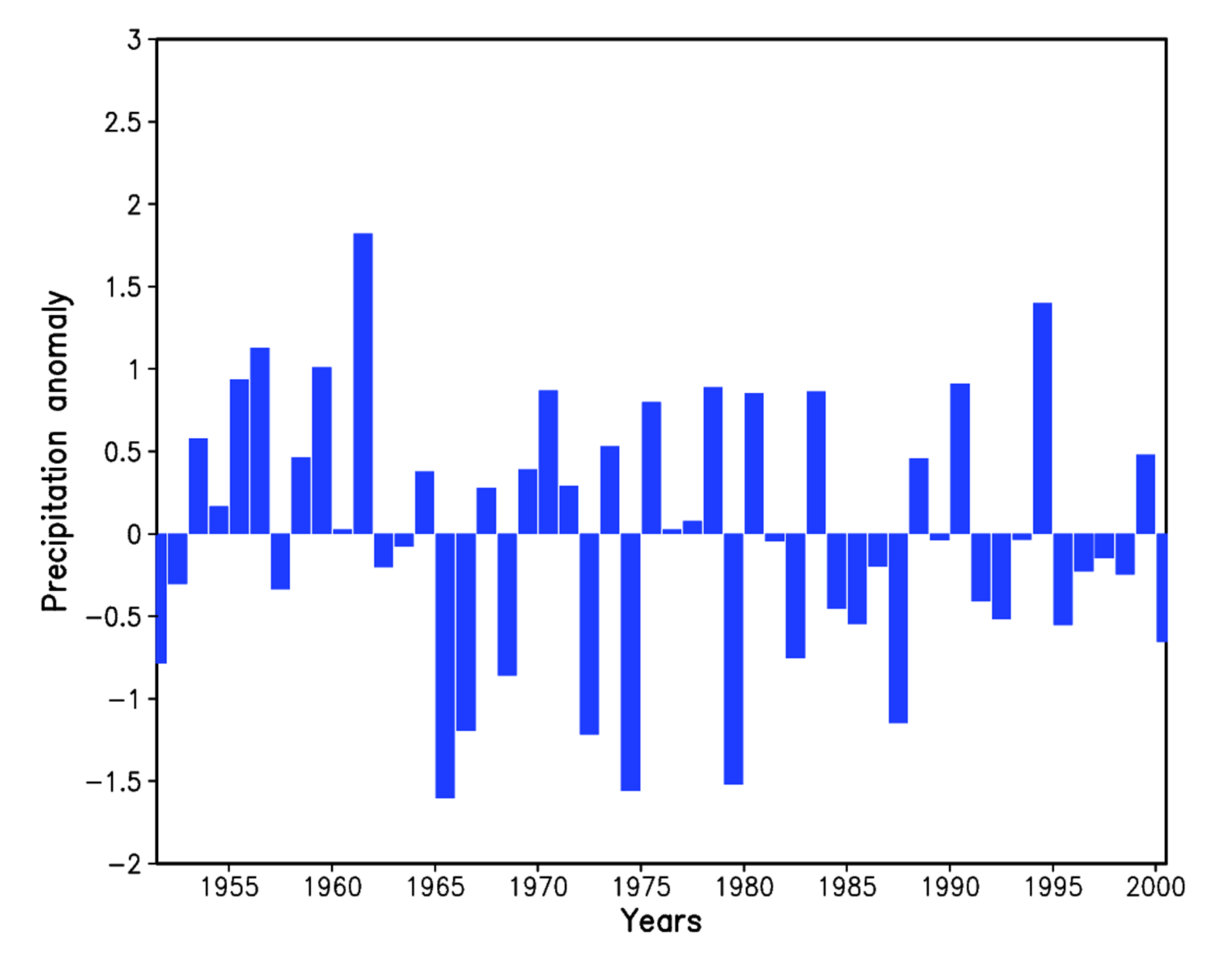
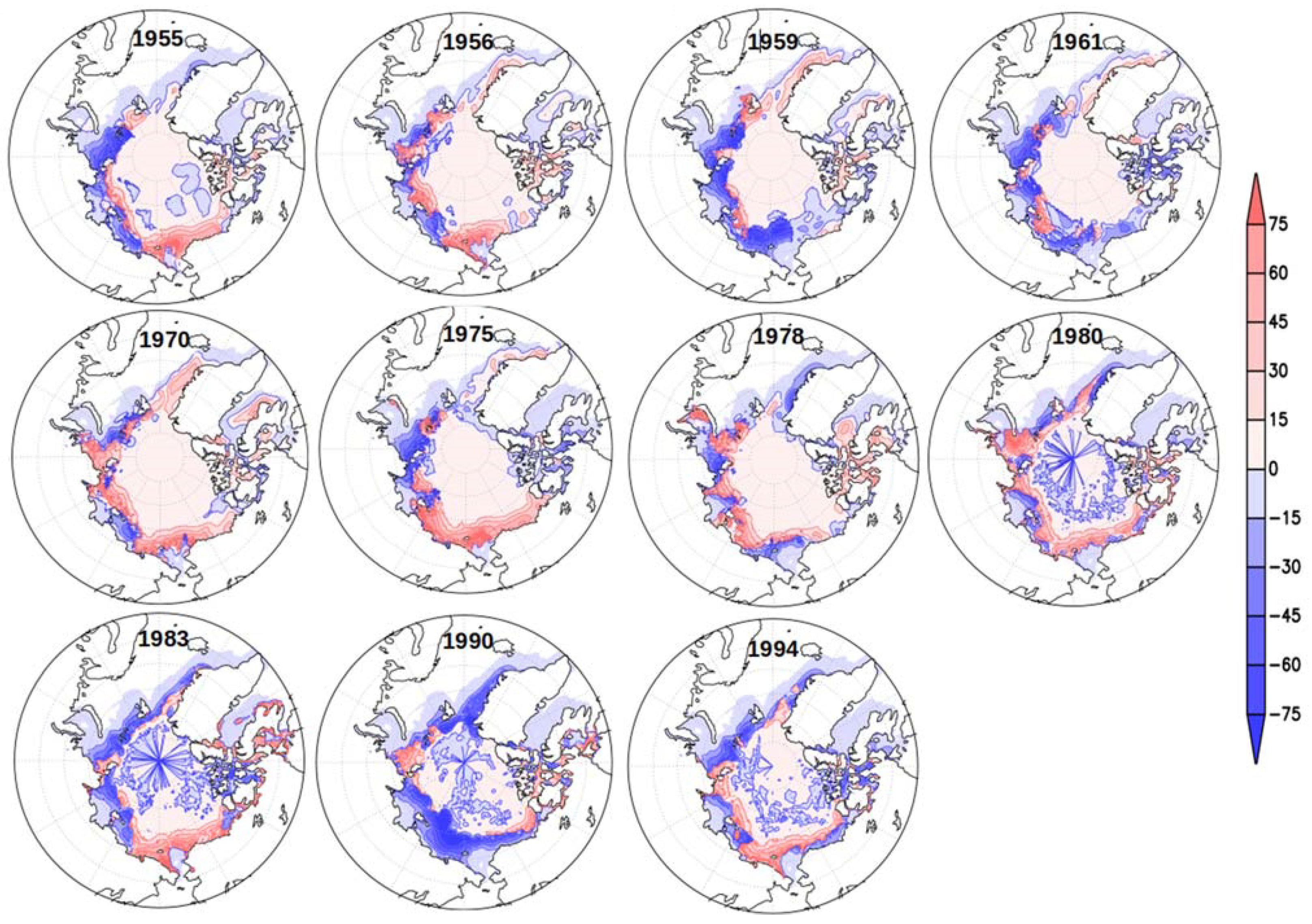

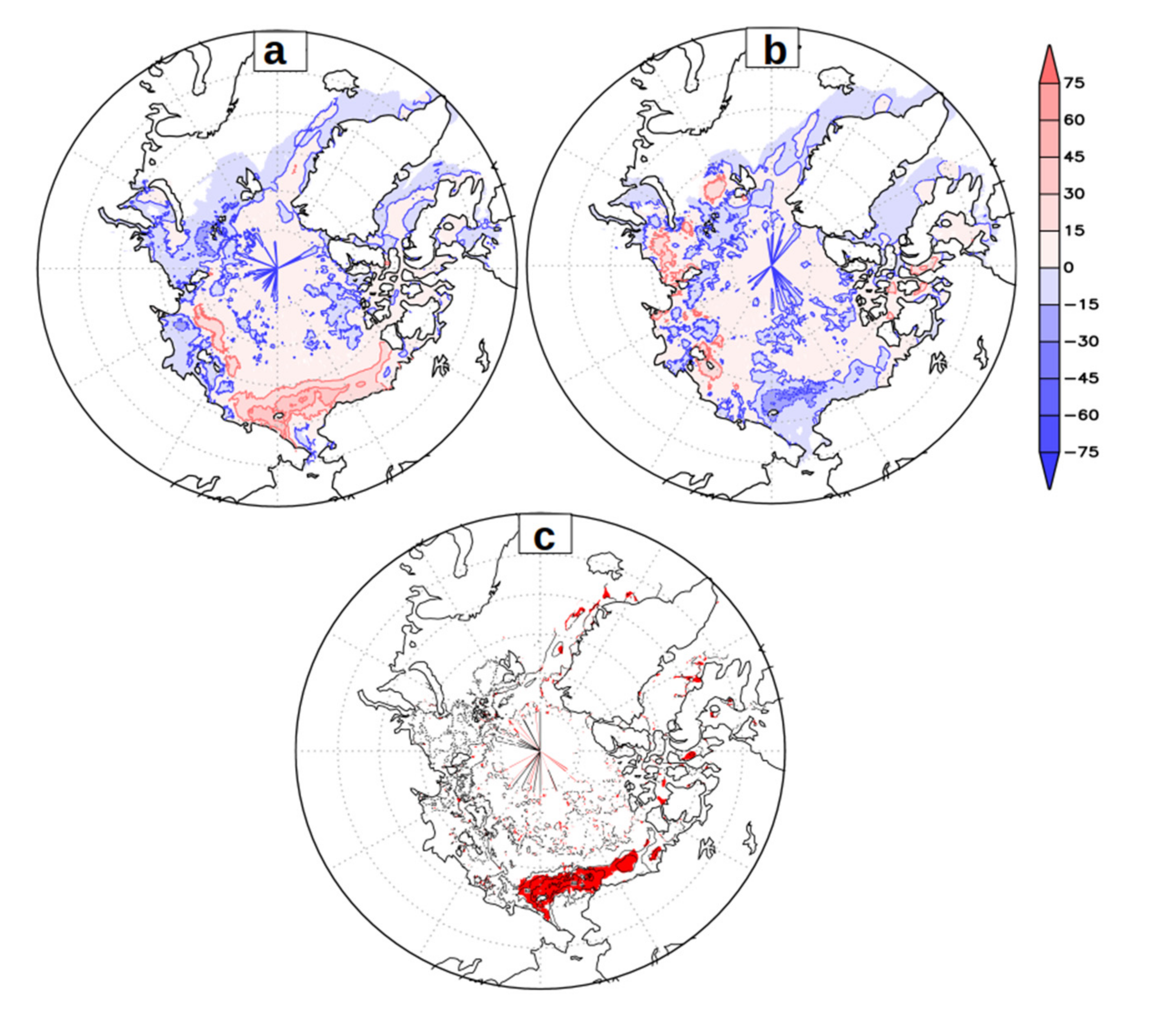
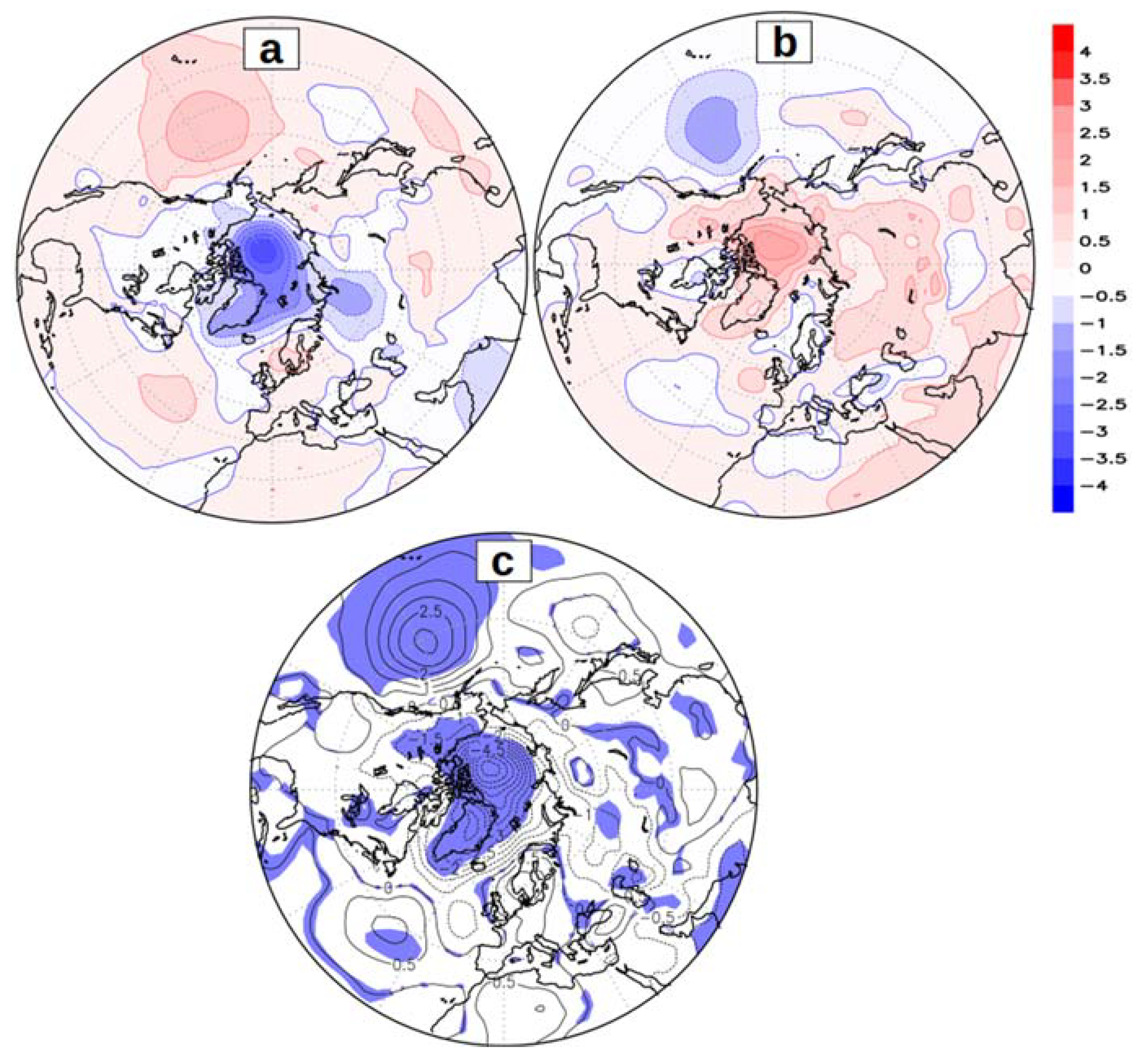
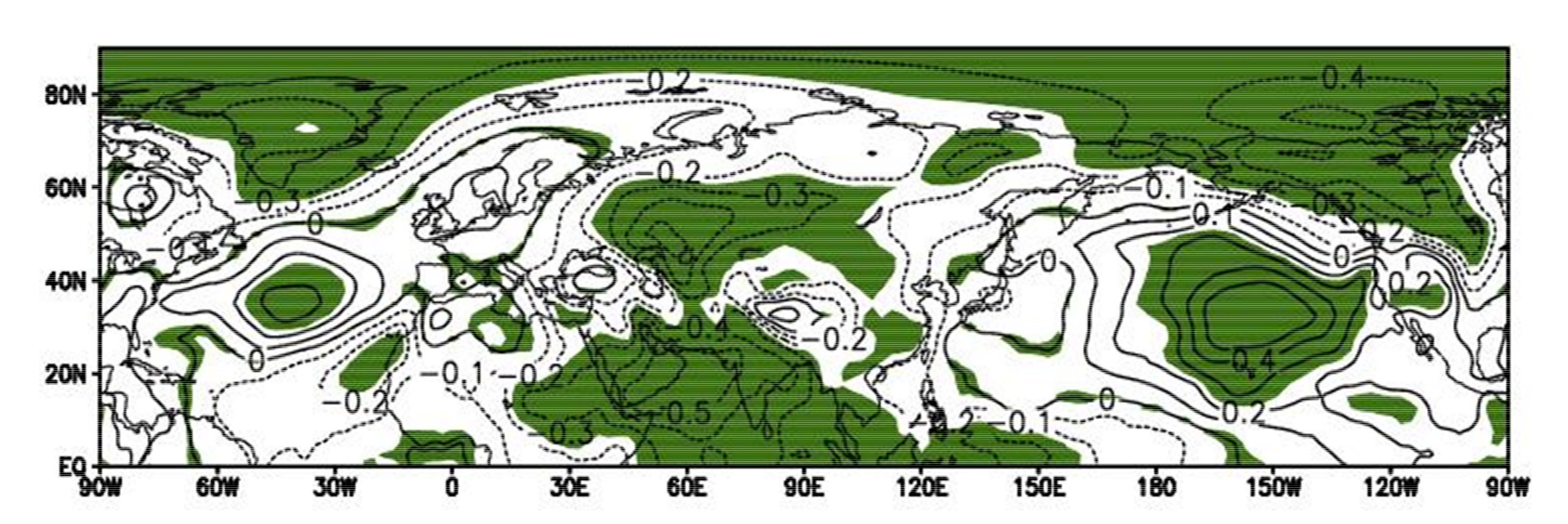
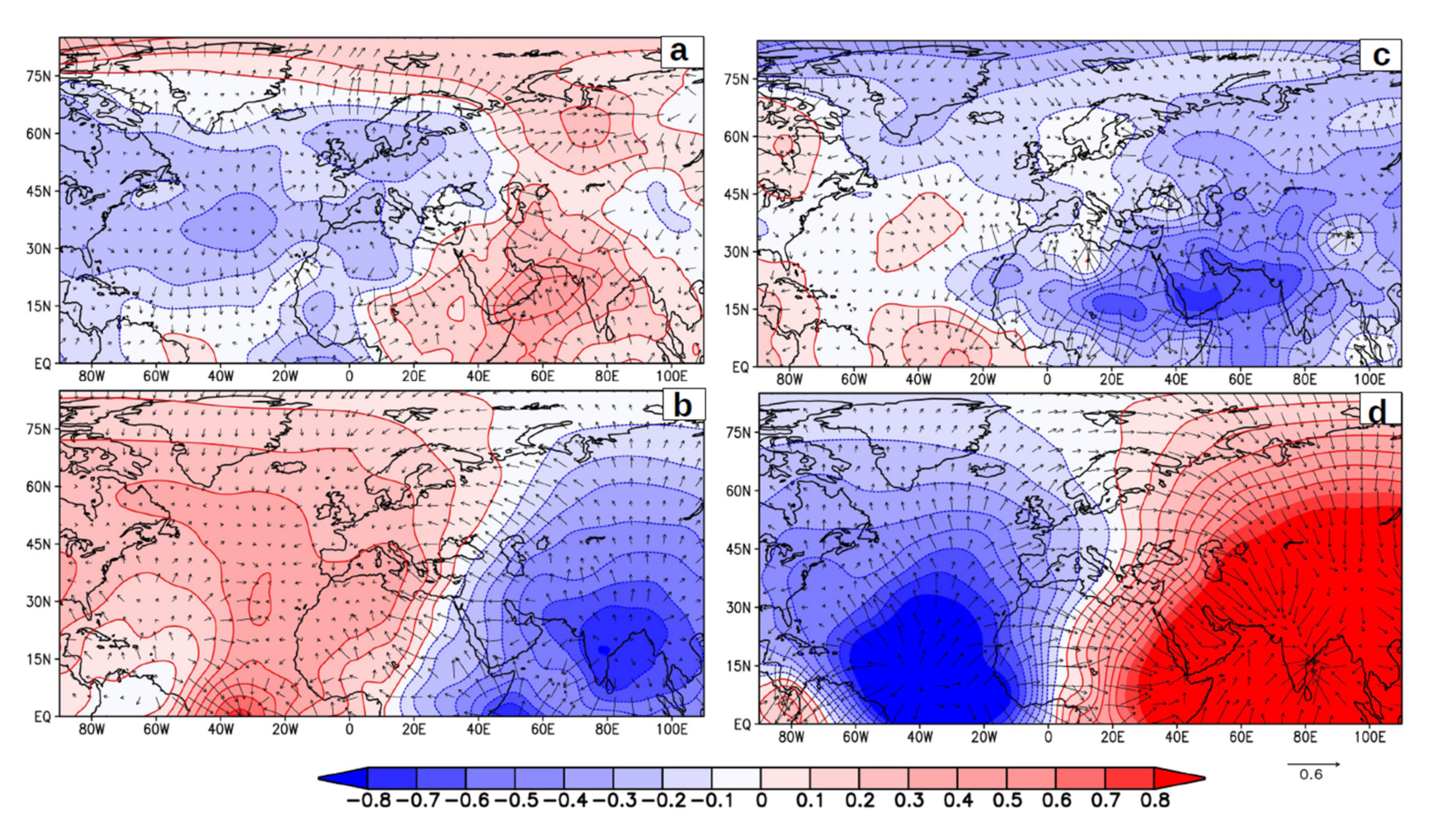
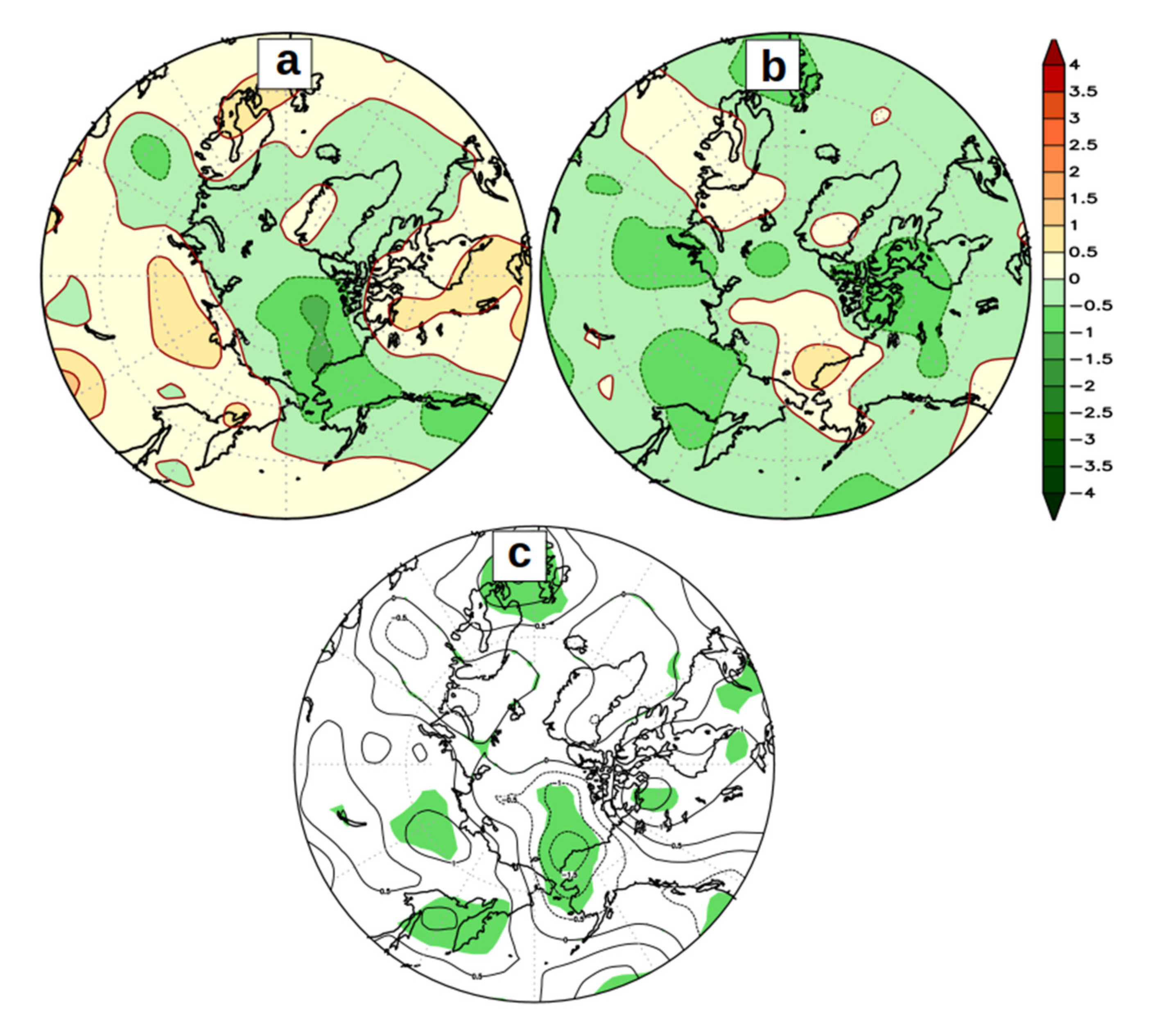
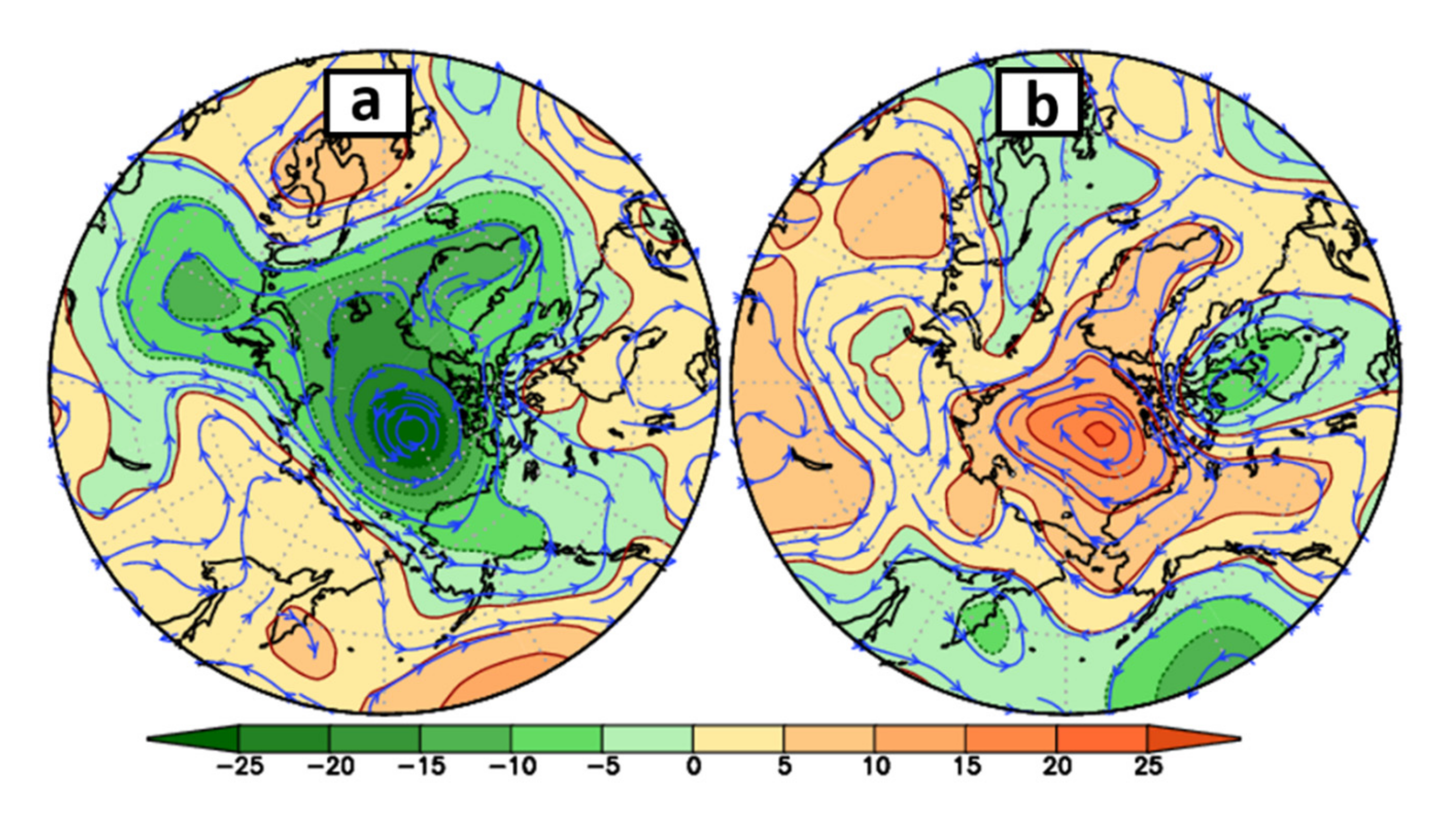
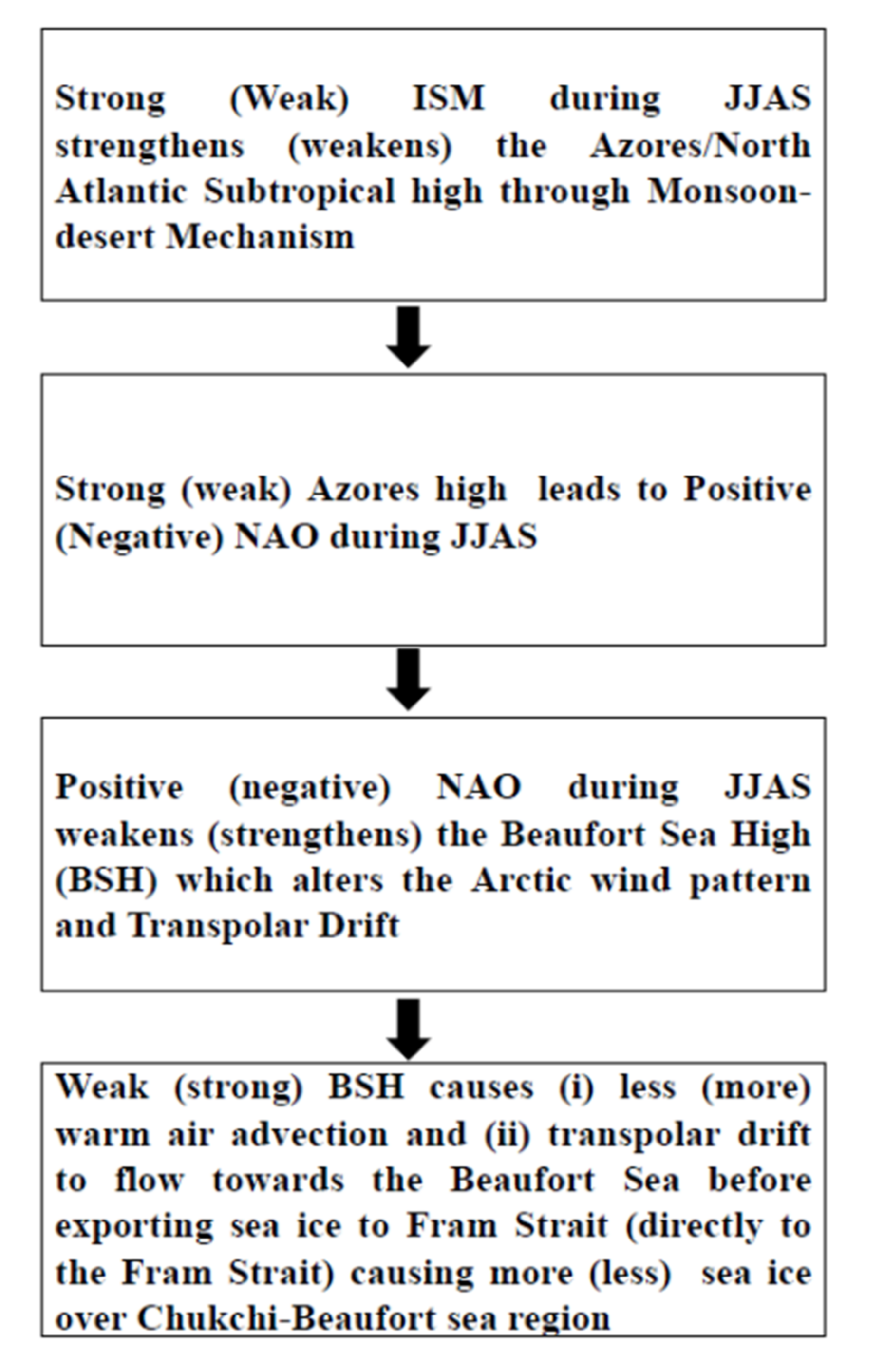
Publisher’s Note: MDPI stays neutral with regard to jurisdictional claims in published maps and institutional affiliations. |
© 2022 by the authors. Licensee MDPI, Basel, Switzerland. This article is an open access article distributed under the terms and conditions of the Creative Commons Attribution (CC BY) license (https://creativecommons.org/licenses/by/4.0/).
Share and Cite
Sundaram, S.; Holland, D.M. A Physical Mechanism for the Indian Summer Monsoon—Arctic Sea-Ice Teleconnection. Atmosphere 2022, 13, 566. https://doi.org/10.3390/atmos13040566
Sundaram S, Holland DM. A Physical Mechanism for the Indian Summer Monsoon—Arctic Sea-Ice Teleconnection. Atmosphere. 2022; 13(4):566. https://doi.org/10.3390/atmos13040566
Chicago/Turabian StyleSundaram, Suchithra, and David M. Holland. 2022. "A Physical Mechanism for the Indian Summer Monsoon—Arctic Sea-Ice Teleconnection" Atmosphere 13, no. 4: 566. https://doi.org/10.3390/atmos13040566
APA StyleSundaram, S., & Holland, D. M. (2022). A Physical Mechanism for the Indian Summer Monsoon—Arctic Sea-Ice Teleconnection. Atmosphere, 13(4), 566. https://doi.org/10.3390/atmos13040566




